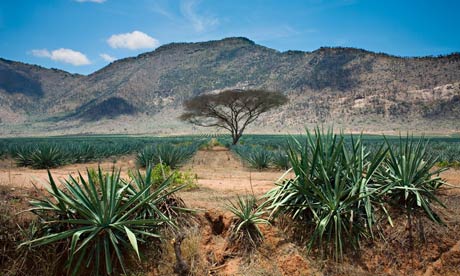The desert plants used to distil tequila could cut emissions from transport by providing an important new biofuel crop, according to new research.
“Agave has a huge advantage, as it can grow in marginal or desert land, not on arable land,” and therefore would not displace food crops, said Oliver Inderwildi, at the University of Oxford.
Much of the ethanol used as a substitute for petrol is currently produced from corn, especially in the US, and has been criticised for driving up grain prices to record levels. A recent inquiry found that laws mandating the addition of biofuels to petrol and diesel had backfired badly and were unethical because biofuel production often violated human rights and damaged the environment.

But the new study found that agave-derived ethanol could produce good yields on hot, dry land and with relatively little environmental impact. The agave plant, large rosettes of fleshy leaves, produces high levels of sugar and the scientists modeled a hypothetical facility in the tequila state of Jalisco in Mexico which converts the sugars to alcohol for use as a fuel.
Inderwildi said the research, published in the journal Energy and Environmental Science, is the first comprehensive life-cycle analysis of the energy and greenhouse gas balance for agave-derived ethanol. The team found the production of agave-ethanol led to the net emission of 35g of carbon dioxide for each megajoule of energy, far lower than the 85g/MJ estimated for corn ethanol. In comparison, burning petrol emits about 100g/MJ and some estimates of corn ethanol suggest it is worse than petrol.
The ethanol made from sugar cane in Brazil scores even better than agave, at just 20g/MJ, but Inderwildi said its success is difficult to replicate outside Brazil because of the nation’s unique combination of water, fertile soil, space and low-carbon hydroelectricity for drying the crops.
The study considered every part of the production cycle, from fertiliser use, drying and even machinery lubricants, as well as the electricity generated by burning the crop residue.
Andrew Smith, a plant scientist at the University of Oxford and a member of the research team, added: “The characteristics of the agave suit it well to bioenergy production, but also reveal its potential as a crop that is adaptable to future climate change. In a world where arable land and water resources are increasingly scarce, these are key attributes in the food versus fuel argument, which is likely to intensify given the expected large-scale growth in biofuel production.”
Agave biofuel trials are already taking place, in Australia for example. But some experts experts think abandoned agave plantations in Mexico and Africa could be reclaimed for biofuel. These agave plantations were used to produce the fibre sisal, used in rope and dartboards, but fell into disuse as it was replaced by plastics.
But Inderwildi, head of low-carbon motility at Oxford’s Smith School of Enterprise and the Environment, warns that while biofuels can play a crucial role in cutting emissions from vehicles, more action will be needed to tackle global warming. “Biofuels will not be enough without changes on the demand side too, as we don’t have enough land for both fuels and food,” he said, suggesting more fuel efficient engines and electric cars would both be key. “We are not going to fuel the entire US car fleet, for example, on biofuels.”
He thinks biofuel from grasses and agricultural waste – cellulosic sources – can also play a role, but that reductions in the energy used to break down the tough cellulose are needed.
“The only game changer I see is algae, as you can get a lot of fuel in a desert environment,” he said, noting Exxon Mobil’s large investment in algal biofuels and biology pioneer Craig Venter’s aim to bioengineer more productive algae. “It will be at least a decade before it will be at large scale, but with all that brain power working with that amount of money, I am pretty optimistic.”
 Follow
Follow